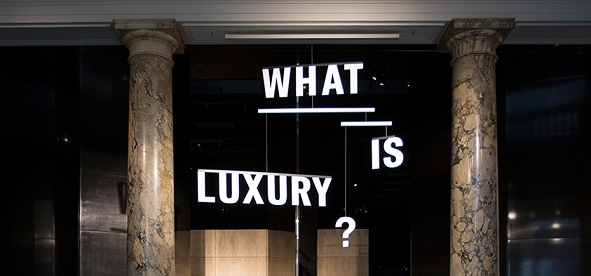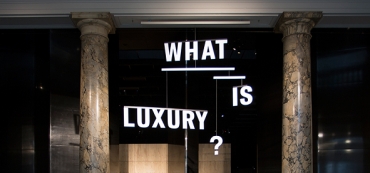

What is luxury? So posed the question, quite literally, by the V&A Museum in a recent exhib
ition. On the bright Spring day that day I visited, it was both telling and unsurprising to be entranced by the expectant queue for the Alexander McQueen Savage Beauty snaking around the foyer, while visitors slipped slowly in and out of the What is luxury? exhibition. Telling, perhaps, of the magnetic power of a brand to drive demand and desire…
Back to our question: What is luxury? Luxury has always defied single definition. If we think back to early examples of luxury creation and consumption in ancient Classical civilization, already a polarisation around luxury was evident. On the one hand, luxury was a concept that was vehemently denied and rejected by the Spartans, on the other it was demonstrably embraced and celebrated (to excess) by the Macedonians. As classicist and historian Dr. Michael Scott explained in an exclusive interview, these different behaviours towards luxury were playing out in the emergence of new words (truphe; poluteles; habrosune) to express different sentiments towards luxury. A new vocabulary of luxury was already in contention.
Today, ‘luxury’ remains one of the most problematised terms in business language. Conversations around what luxury means will range from the external to the internal, from statements of status to a deeper sense of discovery and learning, from the superficial and superfluous, to truly unique products and experiences that will be treasured for a lifetime. The world still has a love-hate relationship with luxury.
What is consistent through the ages, is that we understand luxury differently dependent upon culture. This was our starting point when we undertook our research to examine the meaning of luxury, culminating in the publication of Meta-luxury: brands and the culture of excellence in 2012. When a branded t-shirt and a unique, one-of-a-kind supercar, crafted to the highest specification and bearing the mark of the craftsman can both be called ‘luxury’, clearly we have a problem.
In the research that we undertook, in seeking to understand the true heart of luxury and the implications for brand and business management, the conclusion that we arrived at was excellence and specifically a culture of excellence. Leading luxury brands have always set the standard. They have led the way. In their pursuit of perfection, in their quest for excellence, they break the rules, they challenge the norm, they test the limits of innovation. To the consumer, the creations and experiences afforded by these brands represent an ultimate in desire and fulfillment.
As we explored brands through the lens of a culture of excellence, we asked how many brands actually represent a unique achievement? How many of them are based on distinctive knowledge of some kind? How many are interested in their place in history? Through the concept of Unique Achievement and the drivers of demand of Craftsmanship, Focus, History and Rarity, meta-luxury is a business model that reflects the culture of excellence, drawing a clear line between luxury as a convention and excellence as an authentic conviction.
Three years on from Meta-luxury entering the public domain, it is an interesting point of reflection and prediction to look at what those drivers of Craftsmanship, Focus, History and Rarity mean today. And crucially what they mean for the luxury consumers of tomorrow.
Perhaps the real question to be asked and engaged with is what does luxury mean for a consumer in the Age of You? If we take a step back and consider how brands have evolved over the years, we can begin to chart a fascinating series of dynamics that have played out, the current culmination of which will have considerable ramifications for everyone in the privileged position of guardians of luxury brands around the world.
Brands have evolved and emerged through a series of what we might term as different ‘Ages’:
The Age of Identity, where brand acted as a tool to identify and differentiate and where brand messaging was articulated primarily via one-way communication.
The Age of Value where brand was used to inform and improve decision-making and where brand performance was measured in its ability to deliver financial returns to the business.
The Age of Experience where brand became the higher purpose that inspired a connected ecosystem.
And ultimately, we arrive at the cusp and emergence of The Age of You, where brand is becoming the consumer’s partner. Brand experiences will be unique to the individual and highly customised based on personal information and brand performance is measured in its ability to capture and leverage data and engender participation.
Across those eras, the role of brand has shifted, from brand as a monologue, to brand as a dialogue, to brand as a communal experience, and, now, to brand as a truly personalized and curated experience created around each and every one of us.
In the Age of You, enabled by intelligent infrastructure and powered by big data, the leading brands will develop integrated ecosystems of experiences and reshape the world around us. As people and devices become more connected and everything becomes “smarter,” businesses are recognising the need to reorganize themselves around ‘you’. As a result, each of us will become our own marketplace or “mecosystem.” As “intelligent everything” meets the mecosystems of the future, brands will have unprecedented opportunity to create context, creative possibilities, and meaning for individuals—and value for all. And therein lies the challenge.
We see the first surge of this debate rippling through the luxury industry. Condé Nast hosted their first luxury conference this Spring, with Suzy Menkes leading the debate on ‘Hard Luxury’ and how the concept of luxury is evolving. The FT Business of luxury discussed ‘Technology, Legacy and the New Consumer’. The forthcoming International New York Times Luxury Conference will look at ‘Luxury beyond product’ and connecting with consumer value systems. The consistent thread is around what we value and why. Why, how and in what form does luxury fit into the mecosystems of individuals?
Fundamentally, luxury brands are arguably more uniquely placed to thrive in The Age of You, as the very concept of personalisation, of the unique and bespoke has been the beating heart of these brands for centuries. And as we reflect on the manifestation of meta-luxury as a culture and business model in The Age of You, we see this already resonating in a number of indicators. Craftsmanship derives from the very premise of demand and desire of something created by an individual for an individual. And we’re seeing a distinct gravitation towards quality of product and an enhanced role of the aesthetic. As we look at the purchase behaviour of affluents, it is telling to see greater primacy towards the understated aesthetic and towards brands such as Céline and Bottega Veneta. The inimitable words of Bottega Veneta seem to encapsulate it beautifully: “When your own initials are enough.” History as a driver in meta-luxury is about the creative tension of tradition and innovation. It is about how brands carry forward their origins into the future, staying true to their DNA and making it relevant for new generations. Never before has this been more vital or valuable for brands.
One of the most powerful dynamics in the Age of You is the knowledge economy. The assertion of the self is on an inexorable rise, and concomitant with that is the desire to demonstrate one’s own knowledge capital. There is a value to the personal economy of being ‘in the know’ about brands that remain otherwise off the radar to others. There is a value in Focus, in a depth of specialisation, in the exacting lens of a brand which commands aspiration and desire above others. There is a value in a brand that has opened up a window onto its world that is not available to others.
In The Age of You, the fine line between what luxury brands reveal and conceal as they engage with the transparency demanded of consumers and the element of mystery that is endemic to their very being, will be fascinating to watch.
Authored by Rebecca Robins,Director EMEA LatAm, for Interbrand
Source:Interbrand
